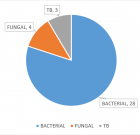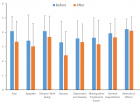Abstract
Research Article
Impact of Biofertilizers & Different doses of NPK on Growth and Photosynthetic Pigments of Okra Plant (Abelmoschus Esculentus L. Moench)
Reena Kujur*, Heba I Khan, Eugenia P Lal and Lalit Kumar Verma
Published: 01 September, 2023 | Volume 7 - Issue 3 | Pages: 092-096
Okra is an herbaceous hairy annual plant that belongs to the family Malvaceae. It is cultivated in tropical, subtropical, and warm temperate regions around the world. The present work was carried out to study the effect of biofertilizers (Azotobacter + Bacillus) and different concentrations of Nitrogen, Phosphorus, and Potassium i.e.NPK on growth and photosynthetic pigments of okra (Abelmoschus esculentus L. Moench). Okra can be named a multipurpose crop as its various parts such as leaves, buds, flowers, pods, stems and seeds can be used for different purposes [1]. Okra is rich in dietary fiber, vitamins, oils, etc. Application of hazardous fertilizers causes a nutrient imbalance in soil, With respect to reducing the causes due to chemical fertilizers, biofertilizers are suited best to maintain higher productivity and yield of crops. Random block design (RBD) was selected as an experimental design. The treatments combination taken are T0- Control, T1- Azotobacter + 50% NPK, T2- Azotobacter (2.5 kg/ha) + 100% NPK, T3- Bacillus (2.5 kg/ha) + 50% NPK, T4- Bacillus (2.5 kg/ha) + 100% NPK, and T5 with NPK 100%. The final result revealed, that the treatment combination with Azotobacter + 100% NPK (T2) showed the highest value of plant height (65.60 cm), number of leaves per plant(62.36), number of flowers per plant (27.40), and also carotenoid content (2.82 mg/g), chlorophyll a(2.47 mg/g) and chlorophyll b(3.25 mg/g) were observed maximum. So, it can be concluded through this paper that the combination of Azotobacter 2.5 kg/ha + 100% NPK (T2) is suitable for the okra plant for better growth and enhancement of photosynthetic potential in-field practices.
Read Full Article HTML DOI: 10.29328/journal.jpsp.1001112 Cite this Article Read Full Article PDF
Keywords:
Azotobacter; Bacillus; Okra; Chlorophyll
References
- Gemede HF, Ratta N, Haki GD, Woldegiorgis AZ, Beyene F. Nutritional quality and health benefits of okra (Abelmoschus esculentus): A review. J Food Process Technol. 2015;6(458): 2.
- National Horticulture Board (2022) Govt. of India. Area production statistics estimation of Horticultural crops. website- https://www.nhb.gov.in/StatisticsViewer
- Adelakun OE, Oyelade OJ, Ade-Omowaye BI, Adeyemi IA, Van de Venter M. Chemical composition and the antioxidative properties of Nigerian Okra Seed (Abelmoschus esculentus Moench) Flour. Food Chem Toxicol. 2009 Jun;47(6):1123-6. doi: 10.1016/j.fct.2009.01.036. PMID: 19425185.
- Arapitsas P. Identification and quantification of polyphenolic compounds from okra seeds and skins. Food Chem. 2008 Oct 15;110(4):1041-5. doi: 10.1016/j.foodchem.2008.03.014. Epub 2008 Mar 18. PMID: 26047300.
- Liao H, Dong W, Shi X, Liu H, Yuan K. Analysis and comparison of the active components and antioxidant activities of extracts from Abelmoschus esculentus L. Pharmacogn Mag. 2012 Apr;8(30):156-61. doi: 10.4103/0973-1296.96570. PMID: 22701290; PMCID: PMC3371438.
- Sreenivasa MN, Nagaraj M Naik, Bhat SN. Beejamruth: A source for beneficial bacteria. Karnataka. J Agric Sci. 2010; 17(3):72-77.
- Raj AK, Geetakumari VL. Effect of organic manures and Azospirillum inoculation on yield and quality of OKRA (Abelmoschus esculentus L. Moench). Veg Sci. 2001; 179-181.
- Nambiar KKM, Abrol IP. Long term fertilizer experiment in India-An overview. Fertilizers News. 1992; 34:11-26.
- Adekiya AO, Aboyeji CM, Dunsin O, Adebiyi OV, Oyinlola OT. Effect of urea fertilizer and maize cob ash on soil chemical properties, growth, yield, and mineral composition of okra, Abelmoschus esculentus(L.) Moench. J Hortic Res. 2018; 26(1): 67–76. https://doi.org/10.2478/johr-2018-0008 .
- Adekiya AO, Agbede TM, Aboyeji CM, Dunsin O, Ugbe JO. Green manures and NPK fertilizer effects on soil properties, growth, yield, mineral and vitamin C composition of okra (Abelmoschus esculentus(L.) Moench). J Saudi Soc Agric Sci. 2019; 18: 218–223. https://doi.org/10.1016/j.jssas.2017.05.005.
- Khandaker MM, Jusoh N, Ralmi NHA, Ismail SZ. The effect of different types of organic fertilizers on growth and yield of Abelmoschus esculentus Moench (okra). Bulg J Agric Sci. 2017; 23(1): 119–125.
- Mal B, Mahapatra P, Mohanty S, Mishra N. Growth and yield parameters of okra (Abelmoschus esculentus) influenced by Diazotrophs and chemical fertilizers. J Crop and Weed. 2013; 9(2): 109-112.
- Chahal HS, Singh S, Dhillon IS, Kaur S. Effect of integrated nitrogen management on macronutrient availability under cauliflower (Brassica oleracea var. botrytis L.). International Journal Current Microbiology Applied Sciences. 2019; 8(4): 1623-1633.
- Baker NR. Chlorophyll fluorescence: a probe of photosynthesis in vivo. Annu Rev Plant Biol. 2008;59:89-113. doi: 10.1146/annurev.arplant.59.032607.092759. PMID: 18444897.
- Yang J, Kloepper JW, Ryu CM. Rhizosphere bacteria help plants tolerate abiotic stress. Trends Plant Sci. 2009 Jan;14(1):1-4. doi: 10.1016/j.tplants.2008.10.004. Epub 2008 Dec 4. PMID: 19056309.
- Radhakrishnan R, Hashem A, Abd Allah EF. Bacillus: A Biological Tool for Crop Improvement through Bio-Molecular Changes in Adverse Environments. Front Physiol. 2017 Sep 6;8:667. doi: 10.3389/fphys.2017.00667. PMID: 28932199; PMCID: PMC5592640.
- Aasfar A, Bargaz A, Yaakoubi K, Hilali A, Bennis I, Zeroual Y, Meftah Kadmiri I. Nitrogen Fixing AzotobacterSpecies as Potential Soil Biological Enhancers for Crop Nutrition and Yield Stability. Front Microbiol. 2021 Feb 25;12:628379. doi: 10.3389/fmicb.2021.628379. PMID: 33717018; PMCID: PMC7947814.
- Konde BK, Shinde PA. Effect of Azotobacter chroococcum and inoculations under graded levels of nitrogen on yield of sorghum, maize, pearl millet and wheat. Cereal nitrogen fixation: Proc.working group meeting, ICRISAT center, Patancheru, A.P. 1986
- Wellburn AR. The spectral determination of chlorophylls a and b, as well as total carotenoids, using various solvents with spectrophotometers of different resolution. Journal of Plant Physiology. 1994;144(3): 307-313.
- Vicas S, Laslo V, Pantea S, Bandici G. Chlorophyll and carotenoids pigments from Mistletoe (Viscum album) leaves using different solvents. Analele Universitatii din Oradea, Fascicula Biologie. 2010;17(2): 213-218.
- Fisher RA. Statistical methods for research workers. In Breakthroughs in statistics: Methodology and distribution. New York, NY: Springer New York. 1970; 66-70.
- Gomez KA, Gomez AA. Statistical procedures for agricultural research, 2nd edn. Wiley India Pvt Ltd, Delhi. 2010; 1-657.
- Meyer BS, Anderson DB. Nitrogen and phosphorus leaching during the decomposition of broad leaf forest litter. Polish J Soil Sci. 2003; 36: 21-29.
- Umesha S, Singh PK, Singh RP. Microbial biotechnology and sustainable agriculture. In Biotechnology for sustainable agriculture, ed. RL. Singh, S Monda, Chap. 6. 2018; 185-205.
- Dhawale AB, Warade SD, Bhangre KK. Integrated nutrient management in Bhindi. Asian J Hort. 2011; 6(1): 145-147.
- Panda N, Dhal A. Nutrient management in okra (Abelmoschus esculentus L. Moench) under coastal alluvial soil of Jagatsinghpur, Orissa. Orissa J Hort. 2018; 36(1): 88-91.
- Singh JK, Bahadur A, Singh NK, Singh TB. Effect of using varying level of NPK and biofertilizers on vegetative growth and yield of okra (Abelmoschus esculentus L. Moench). Veg Sci. 2010; 37(1): 100-101.
- Ghuge MB, Lekhi R, Karcho S, Kumar A. Influence of integrated nutrient management on growth and seed yield of okra (Abelmoschus esculentus (L.) Monech) cv. VRO-6. Environ Ecol. 2015; 33(3): 1073-1076.
- Fayaz Kh, Singh D, Singh VK, Bashir D, Kuller LR. Effect of NPK on plant growth, flower quality and yield of gerbera (Gerbera jamesonii). Research in Environment and Life Sciences. 2016; 9(11): 1361-1363. ISSN: 0974-4908.
- Ayemi TJ, Singh D, Fatmi U. Effect of NPK on Plant Growth, Flower Quality and Yield of Gerbera (Gerbera jamesonii L.) cv. Ruby Red under Naturally Ventilated Polyhouse Condition. International Journal of Current Microbiology and Applied Sciences. 2017; 6(8): 1049-1056.
- Joshi VI, Patel HC, Patel JS, Patel PD. Role of organic manures, nitrogen and phosphorous on growth and seed yield of okra (Abelmoschus esculentus L. Moench). Trends in Biosciences. 2017;10(31): 6678-6682.
- El Kinany S, Achbani E, Faggroud M, Ouahmane L, El Hilali R, Haggoud A, Bouamri R. Effect of organic fertilizer and commercial arbuscular mycorrhizal fungi on the growth of micropropagated date palm cv. Feggouss. Journal of the Saudi Society of Agricultural Sciences. 2019; 18: 411-417.
- Ramakrishnan K, Selvakumar G. Effect of biofertilizers on enhancement of growth and yield on Tomato (Lycopersicum esculentum Mill.). International J Research in Botany. 2017; 2(4): 20-23.
- Kadlag RR, Kapadiya PK, Bhor PB, Chandore HD, Joshi MD. Effect of organic, inorganic fertilizer and biofertilizers on growth of okra (Abelmoschus esculentus L. (Moench)) cv. Gujarat Okra-2. Haryana J Hort Sci. 2010; 39(3/4): 316-317.
- Al-Sayed HM, Hegab SA, Youssef MA, Khalafalla MY, Almaroai YA, Ding Z, EissaMA. Evaluation of quality and growth of roselle (Hibiscus sabdariffa) as affected by bio-fertilizers. Journal of Plant Nutrition. 2020; 43: 1025-1035. DOI: 10.1080/01904167.2020.1711938
- Kumar G, Singh R, Mishra R. Biofertilizer and chemical fertilizer induced changes in cyto-morphological and biochemical constituents of Foeniculum vulgare Mill. Curr Bot. 2020; 4(2): 7-13.
- Al-Erwy AS, Bafeel SO, Al-Toukhy A. Effect of Chemical, Organic and Bio Fertilizers on Germination, Growth and yield of Wheat (Triticum aestivum L) Plants Irrigated With Sea Water. Seeds. 2016; 10: 100.
Figures:

Figure 1

Figure 2
Similar Articles
-
Chlorophylls and xanthophylls of crop plants as dyes for Dye-Sensitized Solar Cells (DSSC)Forni C*,Rossi M,Matteocci F,Di Carlo A. Chlorophylls and xanthophylls of crop plants as dyes for Dye-Sensitized Solar Cells (DSSC). . 2017 doi: 10.29328/journal.jpsp.1001011; 1: 087-094
-
Bacillus amyloliquefaciens as a plant growth promoting bacteria with the interaction with of grass salt Distichlis palmeri (Vasey) under field conditions, in desert of Sonora, MexicoRueda Puente Edgar O*,Ruiz Alvarado Cristina,Jesús Borboa Flores,Victor Cardenas Salazar,Soto Ortiz Roberto,Lourdes Díaz Cervantes. Bacillus amyloliquefaciens as a plant growth promoting bacteria with the interaction with of grass salt Distichlis palmeri (Vasey) under field conditions, in desert of Sonora, Mexico. . 2018 doi: 10.29328/journal.jpsp.1001021; 2: 059-067
-
Nematicidal effect of abamectin, boron, chitosan, hydrogen peroxide and Bacillus thuringiensis against citrus nematode on Valencia orangSherin FA Awd Allah*,Sandy E Hammad,MAM El-Saedy. Nematicidal effect of abamectin, boron, chitosan, hydrogen peroxide and Bacillus thuringiensis against citrus nematode on Valencia orang. . 2019 doi: 10.29328/journal.jpsp.1001041; 3: 111-117
-
The use of Bacillus thuringiensis to control plant-parasitic nematodesYolanda Bel,Magda Galeano,Mireya Baños-Salmeron,Baltasar Escriche*. The use of Bacillus thuringiensis to control plant-parasitic nematodes. . 2022 doi: 10.29328/journal.jpsp.1001076; 6: 062-064
-
Impact of Biofertilizers & Different doses of NPK on Growth and Photosynthetic Pigments of Okra Plant (Abelmoschus Esculentus L. Moench)Reena Kujur*, Heba I Khan, Eugenia P Lal, Lalit Kumar Verma. Impact of Biofertilizers & Different doses of NPK on Growth and Photosynthetic Pigments of Okra Plant (Abelmoschus Esculentus L. Moench). . 2023 doi: 10.29328/journal.jpsp.1001112; 7: 092-096
-
Management of Chocolate Spot Disease in Faba Bean Plants by using Biological Control MeansAhmed MFA*, Salem EA, Mahmoud MA, Shaheen SI. Management of Chocolate Spot Disease in Faba Bean Plants by using Biological Control Means. . 2023 doi: 10.29328/journal.jpsp.1001120; 7: 142-150
-
The Use of Thioxopyrimidine Derivatives as New Regulators of Growth and Photosynthesis of BarleyTsygankova VA*, Andrusevich YaV, Vasylenko NM, Kopich VM, Solomyannyi RM, Popilnichenko SV, Kozachenko OP, Pilyo SG, Brovarets VS. The Use of Thioxopyrimidine Derivatives as New Regulators of Growth and Photosynthesis of Barley. . 2024 doi: 10.29328/journal.jpsp.1001139; 8: 090-099
-
Plant growth, Yield and Leaf Nutritional value of Jute (Corchorus olitorius L.) as Influenced by Banana Peel levels under Salt Stress conditions in Coastal region of CameroonMathias Julien Hand*,Chimène Fanta Abib,Kingsley Mbi Tabi,Alphonse Ervé Nouck,Libert Brice Tonfack,Victor Désiré Taffouo,Emmanuel Youmbi. Plant growth, Yield and Leaf Nutritional value of Jute (Corchorus olitorius L.) as Influenced by Banana Peel levels under Salt Stress conditions in Coastal region of Cameroon. . 2024 doi: 10.29328/journal.jpsp.1001145; 8: 131-140
Recently Viewed
-
Various Theories of Fast and Ultrafast Magnetization DynamicsManfred Fähnle*. Various Theories of Fast and Ultrafast Magnetization Dynamics. Int J Phys Res Appl. 2024: doi: 10.29328/journal.ijpra.1001101; 7: 154-158
-
Nitrogen Fixation and Yield of Common Bean Varieties in Response to Shade and Inoculation of Common BeanSelamawit Assegid*,Girma Abera. Nitrogen Fixation and Yield of Common Bean Varieties in Response to Shade and Inoculation of Common Bean. J Plant Sci Phytopathol. 2023: doi: 10.29328/journal.jpsp.1001122; 7: 157-162
-
Peripheral perfusion index in critically ill COVID-19 and its association with multiorgan dysfunctionCornu Matias German*, Tonelier Matias, Roel Pedro, Sanhueza Laura, Orozco Sergio Martin, Sepulveda Mariana Elizabet, Svampa Silvana Enrica, Arana Osorio Erick and Martinuzzi Andres Luciano Nicolas. Peripheral perfusion index in critically ill COVID-19 and its association with multiorgan dysfunction. J Clin Intensive Care Med. 2023: doi: 10.29328/journal.jcicm.1001043; 8: 004-013
-
Dalbavancin and moleculight in the COVID-19 pandemicWayne J Caputo*, George Fahoury, Donald Beggs, Patricia Monterosa. Dalbavancin and moleculight in the COVID-19 pandemic. J Clin Intensive Care Med. 2023: doi: 10.29328/journal.jcicm.1001042; 8: 001-003
-
Development of Latent Fingerprints Using Food Coloring AgentsKallu Venkatesh,Atul Kumar Dubey,Bhawna Sharma. Development of Latent Fingerprints Using Food Coloring Agents. J Forensic Sci Res. 2024: doi: 10.29328/journal.jfsr.1001070; 8: 104-107
Most Viewed
-
Evaluation of Biostimulants Based on Recovered Protein Hydrolysates from Animal By-products as Plant Growth EnhancersH Pérez-Aguilar*, M Lacruz-Asaro, F Arán-Ais. Evaluation of Biostimulants Based on Recovered Protein Hydrolysates from Animal By-products as Plant Growth Enhancers. J Plant Sci Phytopathol. 2023 doi: 10.29328/journal.jpsp.1001104; 7: 042-047
-
Sinonasal Myxoma Extending into the Orbit in a 4-Year Old: A Case PresentationJulian A Purrinos*, Ramzi Younis. Sinonasal Myxoma Extending into the Orbit in a 4-Year Old: A Case Presentation. Arch Case Rep. 2024 doi: 10.29328/journal.acr.1001099; 8: 075-077
-
Feasibility study of magnetic sensing for detecting single-neuron action potentialsDenis Tonini,Kai Wu,Renata Saha,Jian-Ping Wang*. Feasibility study of magnetic sensing for detecting single-neuron action potentials. Ann Biomed Sci Eng. 2022 doi: 10.29328/journal.abse.1001018; 6: 019-029
-
Pediatric Dysgerminoma: Unveiling a Rare Ovarian TumorFaten Limaiem*, Khalil Saffar, Ahmed Halouani. Pediatric Dysgerminoma: Unveiling a Rare Ovarian Tumor. Arch Case Rep. 2024 doi: 10.29328/journal.acr.1001087; 8: 010-013
-
Physical activity can change the physiological and psychological circumstances during COVID-19 pandemic: A narrative reviewKhashayar Maroufi*. Physical activity can change the physiological and psychological circumstances during COVID-19 pandemic: A narrative review. J Sports Med Ther. 2021 doi: 10.29328/journal.jsmt.1001051; 6: 001-007

HSPI: We're glad you're here. Please click "create a new Query" if you are a new visitor to our website and need further information from us.
If you are already a member of our network and need to keep track of any developments regarding a question you have already submitted, click "take me to my Query."


















































































































































